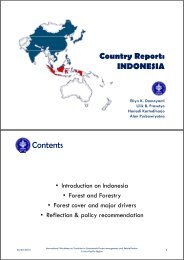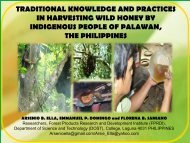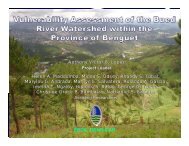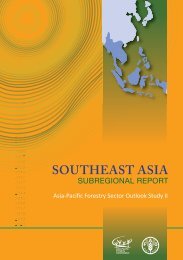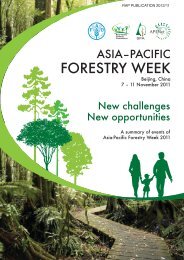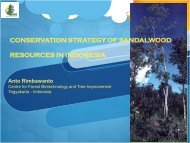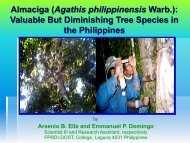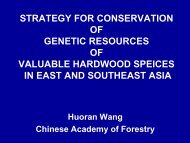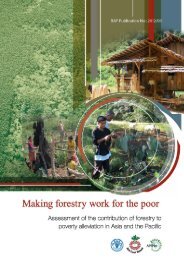Community guidelines for accessing forestry voluntary carbon ... - FAO
Community guidelines for accessing forestry voluntary carbon ... - FAO
Community guidelines for accessing forestry voluntary carbon ... - FAO
You also want an ePaper? Increase the reach of your titles
YUMPU automatically turns print PDFs into web optimized ePapers that Google loves.
ANNEX I<br />
Baseline scenario<br />
What would the future<br />
look like without the<br />
proposed project? What<br />
would the estimated total<br />
<strong>carbon</strong> sequestration/<br />
conservation be without<br />
the project? Explain why<br />
the project is additional<br />
(e.g. without the <strong>carbon</strong><br />
finance the project would<br />
not be financially viable)<br />
Other environmental impacts<br />
Existing vegetation and<br />
land use<br />
What is the current land<br />
cover and land use? Is<br />
tree cover more than 30<br />
percent?<br />
Potential environmental<br />
impacts (positive and<br />
negative) of the project<br />
(Include how to minimize<br />
potential negative effects)<br />
a) Local impacts<br />
b) Global impacts<br />
The future without the extra resources provided by the<br />
<strong>carbon</strong> finance will mean that fewer trees will be planted<br />
and the pressure on the already existing vegetation will<br />
even be greater. We are missing baseline data to be able<br />
to calculate the estimated <strong>carbon</strong> sequestration without<br />
the proposed project. This project is additional given<br />
that at the moment the resources that are provided <strong>for</strong><br />
tree planting are not sufficient to cover large areas in<br />
the region which urgently require tree planting <strong>for</strong> both<br />
re<strong>for</strong>estation and af<strong>for</strong>estation and other sustainable land<br />
management activities.<br />
The area is densely populated and the land use is<br />
predominantly smallholder agriculture. The lake shore<br />
has many wetlands which is valuable <strong>for</strong> the biodiversity.<br />
Forest cover in the Lake Victoria basin is less than 10<br />
percent. In the next phase of project preparation we will<br />
use Landsat images to make:<br />
1. Land use analysis; and<br />
2. Vegetation analysis.<br />
In addition we will use radar images to determine:<br />
1. Sloping pattern; and<br />
2. Watershed division.<br />
Local impacts:<br />
Climate change adaptation and mitigation through the<br />
use of diversified AF-based production systems and the<br />
farmers´ organizations will be promoted. Awareness<br />
raising of global climate change. Increased biodiversity,<br />
conservation of indigenous species, increased tree<br />
coverage, improved microclimate. Benefits from AF<br />
technique include: increased soil coverage, increased soil<br />
fertility, increased land productivity due to efficient use<br />
of land/space, erosion control, protection of watersheds,<br />
hence increased quantity and quality of water, less toxic<br />
smoke from using high caloric value trees <strong>for</strong> fuel wood<br />
supply <strong>for</strong> cooking, energy provision through increased<br />
access to fuel wood and charcoal production from<br />
sustainable production on-farm (sold to urban areas).<br />
181




